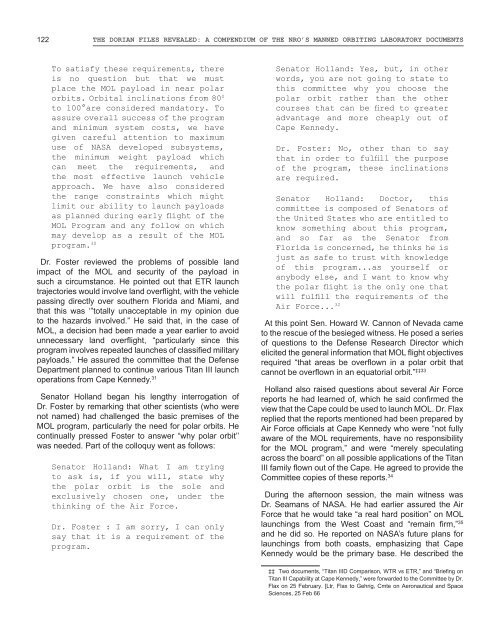NRO-MOL_2015
You also want an ePaper? Increase the reach of your titles
YUMPU automatically turns print PDFs into web optimized ePapers that Google loves.
122 The Dorian Files Revealed: a Compendium of the <strong>NRO</strong>’s Manned Orbiting Laboratory Documents<br />
To satisfy these requirements, there<br />
is no question but that we must<br />
place the <strong>MOL</strong> payload in near polar<br />
orbits. Orbital inclinations from 80 0<br />
to 100°are considered mandatory. To<br />
assure overall success of the program<br />
and minimum system costs, we have<br />
given careful attention to maximum<br />
use of NASA developed subsystems,<br />
the minimum weight payload which<br />
can meet the requirements, and<br />
the most effective launch vehicle<br />
approach. We have also considered<br />
the range constraints which might<br />
limit our ability to launch payloads<br />
as planned during early flight of the<br />
<strong>MOL</strong> Program and any follow on which<br />
may develop as a result of the <strong>MOL</strong><br />
program. 30<br />
Dr. Foster reviewed the problems of possible land<br />
impact of the <strong>MOL</strong> and security of the payload in<br />
such a circumstance. He pointed out that ETR launch<br />
trajectories would involve land overflight, with the vehicle<br />
passing directly over southern Florida and Miami, and<br />
that this was ‘”totally unacceptable in my opinion due<br />
to the hazards involved.” He said that, in the case of<br />
<strong>MOL</strong>, a decision had been made a year earlier to avoid<br />
unnecessary land overflight, “particularly since this<br />
program involves repeated launches of classified military<br />
payloads.” He assured the committee that the Defense<br />
Department planned to continue various Titan III launch<br />
operations from Cape Kennedy. 31<br />
Senator Holland began his lengthy interrogation of<br />
Dr. Foster by remarking that other scientists (who were<br />
not named) had challenged the basic premises of the<br />
<strong>MOL</strong> program, particularly the need for polar orbits. He<br />
continually pressed Foster to answer “why polar orbit’’<br />
was needed. Part of the colloquy went as follows:<br />
Senator Holland: What I am trying<br />
to ask is, if you will, state why<br />
the polar orbit is the sole and<br />
exclusively chosen one, under the<br />
thinking of the Air Force.<br />
Dr. Foster : I am sorry, I can only<br />
say that it is a requirement of the<br />
program.<br />
Senator Holland: Yes, but, in other<br />
words, you are not going to state to<br />
this committee why you choose the<br />
polar orbit rather than the other<br />
courses that can be fired to greater<br />
advantage and more cheaply out of<br />
Cape Kennedy.<br />
Dr. Foster: No, other than to say<br />
that in order to fulfill the purpose<br />
of the program, these inclinations<br />
are required.<br />
Senator Holland: Doctor, this<br />
committee is composed of Senators of<br />
the United States who are entitled to<br />
know something about this program,<br />
and so far as the Senator from<br />
Florida is concerned, he thinks he is<br />
just as safe to trust with knowledge<br />
of this program...as yourself or<br />
anybody else, and I want to know why<br />
the polar flight is the only one that<br />
will fulfill the requirements of the<br />
Air Force... 32<br />
At this point Sen. Howard W. Cannon of Nevada came<br />
to the rescue of the besieged witness. He posed a series<br />
of questions to the Defense Research Director which<br />
elicited the general information that <strong>MOL</strong> flight objectives<br />
required “that areas be overflown in a polar orbit that<br />
cannot be overflown in an equatorial orbit.” ‡‡33<br />
Holland also raised questions about several Air Force<br />
reports he had learned of, which he said confirmed the<br />
view that the Cape could be used to launch <strong>MOL</strong>. Dr. Flax<br />
replied that the reports mentioned had been prepared by<br />
Air Force officials at Cape Kennedy who were “not fully<br />
aware of the <strong>MOL</strong> requirements, have no responsibility<br />
for the <strong>MOL</strong> program,” and were “merely speculating<br />
across the board” on all possible applications of the Titan<br />
III family flown out of the Cape. He agreed to provide the<br />
Committee copies of these reports. 34<br />
During the afternoon session, the main witness was<br />
Dr. Seamans of NASA. He had earlier assured the Air<br />
Force that he would take “a real hard position” on <strong>MOL</strong><br />
launchings from the West Coast and “remain firm,” 35<br />
and he did so. He reported on NASA’s future plans for<br />
launchings from both coasts, emphasizing that Cape<br />
Kennedy would be the primary base. He described the<br />
‡‡ Two documents, “Titan IIID Comparison, WTR vs ETR,” and “Briefing on<br />
Titan III Capability at Cape Kennedy,” were forwarded to the Committee by Dr.<br />
Flax on 25 February. [Ltr, Flax to Gehrig, Cmte on Aeronautical and Space<br />
Sciences, 25 Feb 66

















